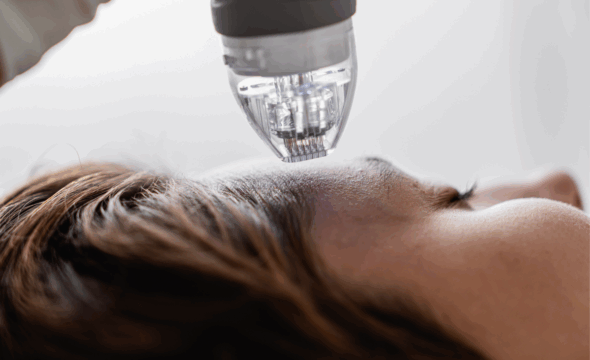What Is Microneedling? Benefits, Procedure & Results Explained
Microneedling is a non-invasive cosmetic procedure that uses fine needles to create tiny punctures in the top layer of the skin. These micro-injuries trigger the body’s natural healing process, prompting the skin to regenerate itself. The technique has gained popularity due to its effectiveness in improving various skin concerns. As one of today’s top facial treatments, microneedling is commonly used to address wrinkles, acne scars, and uneven skin texture. It is a preferred option for those seeking to refresh their appearance without resorting to aggressive chemical peels or lasers.
How Microneedling Works
The Mechanism of Micro-Channels
When a microneedling device passes over the skin, it creates hundreds of controlled micro-channels that penetrate the outermost layer. These tiny entry points act as signals to the body, triggering the skin’s internal repair system to activate. The controlled damage doesn’t harm the skin but stimulates a regenerative response. This healing cycle begins with inflammation, followed by tissue rebuilding and remodeling. As part of the skin needling procedure, the body naturally boosts blood flow to the area. This activity helps to renew the skin’s surface and its deeper layers.
Differences Between Mechanical and Thermal Stimulation
Microneedling relies on precise needle penetration to activate the skin’s repair mechanisms. This differs from treatments like lasers or radiofrequency, which rely on heat to provoke change. Because there’s no thermal injury involved, the risk of hyperpigmentation is reduced. Another advantage of mechanical stimulation is that it doesn’t compromise the outer barrier as harshly as some energy-based options. The needle-based method offers a distinct approach that focuses on natural recovery rather than induced heat damage.
Collagen and Elastin Production
Once the skin begins repairing itself, fibroblast cells within the dermis start producing fresh collagen and elastin. These structural proteins restore firmness and flexibility to the skin, reversing early signs of aging. The stimulation process helps boost collagen production, which smooths rough patches and improves the skin’s resilience over time. The treatment encourages long-term remodeling without significant trauma.
Suits a Variety of Skin Tones
Unlike light-based therapies, microneedling is generally safe for all skin tones because it doesn’t target pigment. This makes it an excellent option for people with medium to deep complexions who may be more prone to post-inflammatory pigmentation after other procedures. The technique works by physically prompting regeneration. Microneedling skin rejuvenation is praised for its adaptability across a broad range of skin types.
Step-by-Step Breakdown of the Procedure
Pre-Treatment Preparation
Properly preparing your skin before a microneedling session is just as important as the treatment itself. Here’s a closer look at what this preparation typically involves:
- Consultation and Skin Assessment: Before any needles touch the skin, a licensed provider will begin with a one-on-one consultation. They assess your current skin health, goals, and medical background. This conversation ensures that microneedling is a safe and appropriate option for you. Individuals with active acne or rosacea flare-ups may be advised to postpone treatment. The practitioner will also evaluate skin tone, thickness, and sensitivity levels to customize the depth and intensity of the best microneedling devices. Skin concerns will guide treatment planning. Setting realistic goals and understanding the limitations of the procedure can prevent dissatisfaction later.
- Discontinue Harsh Topicals: In the days leading up to your appointment, you’ll be instructed to pause use of certain skincare products. Some ingredients can heighten sensitivity and inflammation when used prior to microneedling. Stopping them at least 3–5 days prior gives your skin time to recover and stabilize, reducing the risk of excessive redness, discomfort, or microtears during the procedure. This short break allows the outer layer of the skin to thicken slightly, providing better resistance to the microneedles and leading to more controlled microchannels.
- Focus on Hydration and Barrier Support: Hydrated skin responds better to microneedling. In the days leading up to your appointment, you may be advised to drink plenty of water and incorporate gentle moisturizers into your skincare routine. Well-hydrated skin has more elasticity and resilience, which allows the microneedling device to glide smoothly and minimizes irritation. Avoid anything occlusive or heavy that might clog pores, but do maintain a consistent routine to keep your skin balanced and nourished. Internal hydration is equally important. Ample water intake helps your skin stay supple and prepped from within.
- Thorough Yet Gentle Cleansing: On the day of your session, your provider will begin by cleansing your face with a non-stripping, pH-balanced cleanser. Unlike a deep cleanse, the goal here is to clean without disrupting the barrier or causing redness. Fragrance-free cleansers with calming ingredients are often used. A clean surface is essential for precision, as any lingering product residue or impurities could interfere with the needle penetration.
- Apply Antiseptic: Finally, an antiseptic solution is applied to disinfect the skin. This critical step eliminates bacteria that could otherwise enter the microchannels created by the needles and lead to infection. The antiseptic is applied evenly and allowed to air-dry before the numbing cream is placed.
Taking time to prepare for microneedling properly improves every aspect of the treatment. These steps are simple but vital, creating a clean canvas for the procedure.
Anesthesia Application
A topical numbing cream is applied to the targeted area once the skin is clean and dry. This anesthetic takes about 20 to 30 minutes to take effect, reducing discomfort during the session. After the numbing phase, the practitioner selects an appropriate needle depth, taking into account the patient’s skin type and the specific concern being treated. For surface-level issues like tone and brightness, shorter needles are used. Deeper needles are selected for treating more intense concerns. Tailoring the depth allows practitioners to enhance the treatment’s impact while minimizing unnecessary trauma to the skin.
Device Movement Techniques
During the session, the microneedling device is moved across the skin in a structured pattern, typically in vertical, horizontal, and diagonal motions. This technique ensures that every area receives consistent stimulation, resulting in even outcomes across the entire treatment zone. Practitioners adjust their speed depending on the sensitivity of each region. More delicate areas require lighter strokes.
Immediate Post-Treatment Effects
Directly after treatment, the skin may appear red, similar to a mild sunburn. Slight swelling and a warm sensation are also common in the first few hours. These effects are temporary and a sign that the healing process is underway. The skin might feel tight or dry, and some individuals may notice pinpoint bleeding depending on the depth used. These symptoms usually subside within 24 to 72 hours. The visible start of microneedling recovery time begins immediately, triggering the body’s natural regenerative cycle.
Benefits of Microneedling for Skin Concerns
Smoothing Wrinkles and Fine Lines
Fine lines and wrinkles are among the first visible signs of aging, often resulting from a decline in collagen and elastin levels. Microneedling helps reduce these signs by prompting the skin to rebuild its structural support system. As new collagen forms, it fills in creases and strengthens the surrounding tissue, resulting in smoother, more youthful-looking skin. Unlike some cosmetic procedures that merely tighten the surface, this method works at a deeper level. It supports skin renewal without damaging the outer layer. Individuals who undergo consistent sessions often notice visible improvement, making microneedling for wrinkles a trusted option for age-related concerns.
Reducing Acne Scars and Hyperpigmentation
Microneedling provides a practical solution by encouraging the skin to shed damaged tissue and regenerate new layers. As the treatment stimulates cellular turnover, areas of discoloration begin to fade, and pitted scars become less noticeable. The process is gradual but effective, especially for those seeking a more even and uniform complexion. Additionally, it can help soften the look of older marks that may not have responded to creams or peels. This makes microneedling for acne scars an appealing option for people dealing with stubborn imperfections.
Enhancing Overall Tone and Luminosity
Dull skin often results from a buildup of dead cells and sluggish renewal processes. Microneedling invigorates the skin by increasing circulation and stimulating natural exfoliation. This encourages the development of new skin that reflects light more evenly. The renewed skin also tends to absorb skincare products more effectively, amplifying the benefits of daily routines. For those aiming to elevate their appearance naturally, the glow-inducing microneedling benefits are often a welcome transformation.
Recovery, Aftercare & Expected Results
Do’s and Don’ts of After Microneedling Care
Taking care of your skin after microneedling is essential for achieving the best outcome. Patients should avoid strenuous exercise and hot showers for at least 24 hours to reduce the chance of irritation. Makeup and harsh skincare products should also be avoided for a few days. Patients are encouraged to sleep on clean pillowcases and refrain from touching their faces unnecessarily to keep bacteria away and promote proper recovery.
Timeline for Visible Results
As collagen production increases, the skin starts to feel firmer and more resilient. This improvement continues to build, with peak results often appearing around the three-month mark. People seeking lasting effects usually benefit from a series of treatments spaced four to six weeks apart. The slow but steady development ensures a more natural transformation. Unlike quick fixes, microneedling results are rooted in the body’s healing ability, making them sustainable with proper care.
Role of Serums and Skincare Products Post-Treatment
After a microneedling session, your skin enters a critical phase of rejuvenation. Using the right serums and avoiding harmful ingredients will not only soothe the skin but also accelerate recovery and improve the overall outcome.
- Hydration Recovery: Hyaluronic acid (HA) is ideal because it naturally occurs in the skin and can hold up to 1,000 times its weight in water. Applying an HA serum within a few hours after treatment helps restore hydration to the deeper layers that were accessed during the procedure. Look for a pure, fragrance-free formula without added actives that might irritate. The serum should feel soothing and weightless, not sticky or greasy. Consistent use for the first few days helps reduce tightness, flaking, and redness. The hydration it delivers also supports plumpness and glow, helping you see the early effects of collagen stimulation.
- Avoid Active Ingredients: While your skin is still healing, using potent actives like retinol, glycolic acid, salicylic acid, or vitamin C can do more harm than good. These ingredients are designed to accelerate cell turnover or resurface the skin, but after microneedling, they can cause excessive irritation, stinging, or inflammation. It’s recommended to pause all active exfoliants and retinoids for at least 5–7 days, or longer if your skin still feels tender. Focus on barrier-repairing and calming ingredients such as panthenol, allantoin, or centella asiatica. This short break allows your skin time to build resilience and seal the microchannels naturally, without interference. Once your provider confirms that the skin has returned to baseline, you can slowly reintroduce actives into your regimen for continued benefits.
- Protect with Mineral-Based Sunscreen: Sun protection is essential after microneedling. The treatment makes your skin more sensitive to UV exposure, increasing the risk of sunburn, pigmentation, or long-term damage. Choose a physical (mineral-based) sunscreen that contains zinc oxide or titanium dioxide, as these ingredients are less likely to irritate compromised skin. Look for formulas labeled “broad-spectrum” and with at least SPF 30. Avoid sunscreens with chemical filters, fragrances, or alcohol, as these can be too harsh during the recovery period. Apply sunscreen every morning, even on cloudy days or when you’re mostly indoors, and reapply as needed. Wearing a wide-brimmed hat and staying in the shade also helps shield your skin during this vulnerable time.
The days following microneedling set the stage for your results. By taking these measures seriously, you not only minimize potential setbacks but also ensure your skin emerges stronger and visibly improved.
Comparing Options
Microneedling vs. Laser Resurfacing
One of the key advantages of microneedling is its relatively short downtime compared to more intensive procedures, such as laser resurfacing. While both treatments aim to improve skin texture and appearance, laser methods typically involve more discomfort and more extended recovery periods. Lasers rely on heat to remove damaged skin layers, which can cause more pronounced swelling and sensitivity.
Price Ranges and Add-Ons
The cost of microneedling can vary widely depending on geographic location, provider experience, and any enhancements added to the session. Many clinics offer optional upgrades, such as platelet-rich plasma (PRP) or radiofrequency (RF), to enhance results. These additions come at an extra cost but may accelerate healing and increase collagen stimulation. Compared to other advanced procedures, the base cost of this procedure is often more accessible. However, it’s still important to weigh the overall value, especially when factoring in the number of sessions recommended. When researching microneedling prices, it is also advisable to inquire about package deals or bundled options for multiple treatments.
Choosing whether or not to proceed with microneedling depends on your personal skin goals. A consultation with a qualified provider helps determine how it fits into your long-term care plan. It also ensures that your skin is well-suited for the procedure and that realistic outcomes are discussed. The flexibility of this collagen induction therapy makes it accessible. The journey to healthier skin often starts with a single microneedling facial session guided by expert hands.







